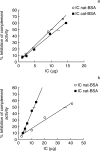Influence of the electric charge of the antigen and the immune complex (IC) lattice on the IC activation of human complement
- PMID: 12084047
- PMCID: PMC2517671
- DOI: 10.1046/j.1365-2613.2002.00224.x
Influence of the electric charge of the antigen and the immune complex (IC) lattice on the IC activation of human complement
Abstract
In order to understand the mechanism of complement (C) activation by immune complexes (ICs), the anti-complementary effect of ICs containing cationized antigens was compared in vitro to that using ICs formed by native antigens. ICs were prepared with affinity-purified rabbit polyclonal IgG antibovine serum albumin (BSA) antibody and either native BSA (isoelectric point 4.2) or BSA rendered cationic by treatment with ethylenediamine (isoelectric point 9.4). Native and cationized antigens were characterized by isoelectric focusing. ICs containing anti-BSA IgG or F(ab')2, formed either at equivalence or in excess of native or cationized antigen, were submitted to ultracentrifugation in a sucrose gradient for mesh size determination. The anti-complementary effect of ICs was evaluated by kinetic determination of haemolytic activity of human serum on haemolysin-sensitized sheep red blood cells. In conditions of antigen excess, the ICs formed by cationized BSA were significantly more efficient in activating human complement than those formed by native antigen. This higher activity was dependent on cationized antigen complexed with complete antibody molecules, as non-complexed cationized BSA or ICs prepared with F(ab')2 fragments were inactive under the same experimental conditions. Furthermore, this difference did not depend on the mesh size of the immune complexes. Our results suggest that the balance between antigen, antibody and C may be of importance in vivo for the onset and course of infections and other pathological processes involving IC formation. ICs containing cationized antigens should be proven of value in experimental models for studies on the regulation of C activation.
Figures



Similar articles
-
Role of antigenic charge and antibody avidity on the glomerular immune complex localization in serum sickness of mice.Clin Exp Immunol. 1986 Jun;64(3):606-14. Clin Exp Immunol. 1986. PMID: 3791693 Free PMC article.
-
In situ formation of subepithelial immune complexes in the rabbit glomerulus: requirement of a cationic antigen.Nephron. 1984;36(4):257-64. doi: 10.1159/000183165. Nephron. 1984. PMID: 6369163
-
Effect of chemical cationization of antigen on glomerular localization of immune complexes in active models of serum sickness nephritis in rabbits.Immunology. 1986 Aug;58(4):529-34. Immunology. 1986. PMID: 3733152 Free PMC article.
-
Stimulation of complement amplification by F(ab')(2)-containing immune complexes and naturally occurring anti-hinge antibodies, possible role in systemic inflammation.Autoimmun Rev. 2008 Jun;7(6):508-13. doi: 10.1016/j.autrev.2008.04.017. Epub 2008 May 12. Autoimmun Rev. 2008. PMID: 18558371 Review.
-
Revisiting immune complexes: Key to understanding immune-related diseases.Adv Clin Chem. 2020;96:1-17. doi: 10.1016/bs.acc.2019.11.001. Epub 2019 Dec 10. Adv Clin Chem. 2020. PMID: 32362316 Review.
Cited by
-
Exploring the Link between Hydrodynamic Size and Immunoglobulins of Circulating Immune Complexes in Rheumatoid Arthritis Patients.Int J Mol Sci. 2024 Mar 8;25(6):3138. doi: 10.3390/ijms25063138. Int J Mol Sci. 2024. PMID: 38542112 Free PMC article.
-
Sequence-based detection of emerging antigenically novel influenza A viruses.Proc Biol Sci. 2024 Aug;291(2028):20240790. doi: 10.1098/rspb.2024.0790. Epub 2024 Aug 14. Proc Biol Sci. 2024. PMID: 39140324 Free PMC article.
-
Mechanisms of immune complex-mediated neutrophil recruitment and tissue injury.Circulation. 2009 Nov 17;120(20):2012-24. doi: 10.1161/CIRCULATIONAHA.108.771170. Circulation. 2009. PMID: 19917895 Free PMC article. Review. No abstract available.
-
Mechanisms of immune-deposit formation and the mediation of immune renal injury.Clin Exp Nephrol. 2005 Sep;9(3):183-91. doi: 10.1007/s10157-005-0357-8. Clin Exp Nephrol. 2005. PMID: 16189625 Review.
References
-
- Barbosa JE. Determinação cinética de atividade anticomplementar PhD Thesis. Faculdade de Medicina de Ribeirão Preto. Universidade de São Paulo; 1983.
-
- Buyon JP, Zuckermann JD. Articular manifestation of systemic lupus erythematosus. In: Lahita RG, editor. Systemic Lupus Erythematosus. London: Churchill Livingstone; 1987. pp. 791–799.
-
- Caughman GB, Boackle RJ, Vesely J. A postulated mechanism for heparin's potentiation of C1 inhibitor function. Mol. Immunol. 1982;19:287–295. - PubMed
Publication types
MeSH terms
Substances
LinkOut - more resources
Full Text Sources

